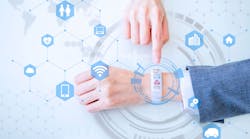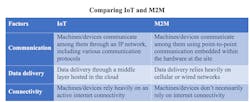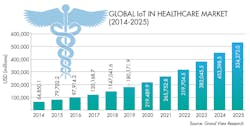As we all know, the Internet of Things (IoT) is a connected network of devices, wherein the devices are connected to each other and to the internet with the help of wireless technology. These devices are rooted with sensors, actuators, electronics, and software solutions, which enables these connected devices to deliver experience in real time.
When we talk about IoT, people often get confused with the term machine-to-machine (M2M) communication. M2M communication and IoT is essentially based on the same concept, i.e., communicating or exchanging data with another machine/device without any human intervention/interfacing. Technically, though, IoT and M2M are two different concepts.
The most important element that the companies should focus on before implementing IoT or M2M concerns their business model, specifically the need to provide add-on value to its customer. Before investing in any such technologies, the companies should think about its effectiveness in its business model and return on investment (ROI).
The Impact of IoT in Smart Devices
The rate of IoT implementation is growing exponentially. Based on the estimates from Intel research, it’s expected that nearly 200 billion devices will be connected by 2020, up from 15 billion in 2015—nearly a 1233% increase. On a global scale, 200 billion connected devices approximately equate to 26 smart devices per person. The surge in adoption of smartphones or any smart devices is one of the key factors depicting the level of awareness regarding connected applications.
- According to statistics published in industry journals, over 25.3% of the global population was reported to use smartphones in 2015, which rose to 33.3% in 2017.
- According to the industry estimates in 2014, the number of mHealth apps on the two leading operating platforms, Android and iOS, had reportedly reached over 100,000 in last 2.5 years.
- Based on the industry data, it’s reported that Western Europe, North America, and the Middle East and Africa have a smartphone penetration rate of over 65%, 64%, and 13.6% of their total population, respectively.
IoT Technology Trends for Healthcare
Growing demand for connected health services to improve the quality of care and surge in adoption of connected medical devices and smartphones are a few factors that have significantly contributed to the technological advances in IoT healthcare. The penetration of these technologies, such as remote disease management, telemedicine, and Health Management Information Systems (HMIS), is expected to expand the scope of IoT in the healthcare industry. In addition, demand for the first-generation smart devices is impacting IoT’s penetration into the healthcare industry.
According to Grand View Research estimates, the IoT in the healthcare market was valued at approximately $98 billion (USD) in 2016. IoT in healthcare involves wireless communication systems of devices and applications to connect patients and healthcare providers to track, diagnose, monitor, and store the vital statistics and medical information.
The chart illustrates the estimates and forecasts in the global healthcare market from 2014 to 2025. (Source: Grand View Research)
Increasing demand for immediate medical attention during medical emergencies and natural disasters, which has boosted the adoption of wearable medical devices, drives the demand for real-time medical intervention. Furthermore, IoT in healthcare is also used to constantly monitor clinical measurements such as blood pressure and glucose, as well as track any movements, medication doses, and real-time home-care treatment.
Various top IT players operating in this space have entered the IoT healthcare market through acquisitions and collaborations with healthcare companies. For instance, IBM collaborated with Medtronic PLC to provide IoT services. Such technologies that are used to monitor and track the quality of care are key factors expected to impact the use of these products.
According to Grand View Research analysis, the market is oligopolistic in nature with few participants dominating the IoT in the healthcare market, namely Microsoft, Philips, Cisco, Cerner, and IBM. These companies have adopted various strategies to gain larger market share: acquire a smaller firm with technical expertise, increase R&D investments, and boost collaborative research initiatives. IBM announced an investment of $3 billion (USD) in IoT in 2015. In April 2018, Microsoft announced it will invest $5 billion (USD) in IoT over the coming four years.
Ongoing IoT Developments for Healthcare Industry
IoT implementation in hospitals can significantly reduce the wait times in emergency rooms. For instance, Mt. Sinai Medical Center in New York City partnered with GE Healthcare in 2013 to develop IoT-driven software called AutoBed. This software can process up to 80 bed requests, track occupancy for 1,200 beds, and track basic patient information, such as nurse proximity. This development had reduced the wait time by 50% in the emergency department of Mt. Sinai Medical Center. Similarly, in 2015, TeleTracking Technologies Inc. also announced a collaboration with GE Healthcare to design an integrated operational platform to reduce waste, improve care delivery, and optimize hospital operations.
Moreover, Philips developed an IoT-driven solution, called e-Alert, in collaboration with OpenMarket, to ensure the accessibility and availability of critical medical hardware. In 2017, Philips received a “most innovative IoT solution” award for its e-Alert system. In 2010, the company also introduced a medical alert service, called Lifeline with AutoAlert, targeting independent living senior citizens to detect patient fall. Other developments include closed-loop insulin delivery (OpenAPS), an implantable long-term continuous glucose monitoring (CGM) system, activity trackers, connected inhalers, ingestible sensors, connected contact lenses, the Apple watch app for fighting depression, and Arthritis—Apple’s ResearchKit software.
Cognitive IoT: The Next Leap for the Healthcare Industry
What is cognitive computing?
The term cognitive is essentially defined as “thinking.” Of course, we’re aware of the fact that computers/machines don’t yet have the capability to think like human being. However, in this case, we’re referring to three terms—understanding, reasoning, and learning.
By understanding, it means the ability to take both structured and unstructured data in its system and establish a model of relationship, concepts, and entities out of it. By reasoning, it means without separately programming for each problem, we can derive a solution from the established model. Similarly, by learning, it means the ability to infer new knowledge from the stored data, both structured and unstructured.
What’s the significance of cognitive computing in IoT?
- Applying machine learning is important for scaling the data derived from the connected devices/machine. The huge amount of data generated from these connected devices can easily overwhelm a human’s ability to analyze and derive patterns out of it.
- This enables us to move beyond machine interface paradigms, which requires a human to learn specialized interface programs to interact with the device/machine. Cognitive computing enables humans to interact with the IoT using its natural language.
- Integration of multiple data sources and types.
In December 2015, IBM announced the opening of global Watson IoT headquarters in Munich, Germany. The company also announced the launch of several new capabilities, offerings, and a different ecosystem of partners to expand the power of cognitive computing to a wide range of connected devices, systems, and sensors. IBM Watson and Microsoft Cognitive Services are among the popular cognitive-computing platforms out there. According to the estimates made by Grand View Research, the global healthcare cognitive-computing market was valued at nearly $738.5 million (USD) in 2014.
Is the IoT a Threat or Opportunity to the Healthcare Industry?
Capturing patient-generated health data is one of the vital parts of patient records. IoT in healthcare is expected to involve mass participation of end users, which may lead to a variety of new potential risks concerning data privacy and security issues. The escalation in incidences of data privacy and security issues is one of the key factors expected to hinder the growth of IoT in healthcare market.
According to the office of Civil Rights in HHS, there were approximately 199 protected health information (PHI) breaches affecting over 7 million patient records in 2013. Moreover, despite the huge benefits of Electronic Health Records (EHRs), public acceptance of EHR technology has been inhibited due to the risks involving the privacy and security of PHI.
For example, in February 2015, the Anthem company was hacked, and the attack exposed over 80 million patients’ PHI. According to various reports, the cases of data breach in the U.S. have increased from approximately 13 in 2008 to over 256 in 2013. As a result, incidences of privacy breaches increased from around 0.5 million to over 9 million in 2014.
However, growing government intervention against healthcare cyberattacks or crimes is one factor that’s looked at as helping to boost the adoption of IoT in various healthcare applications. Other potentially key growth factors for IoT healthcare include the presence of designed information security, privacy, and data-protection authority.
Since 2006, the U.S. government has spent over 100 billion on the development of cybersecurity infrastructure. Furthermore, for the fiscal year 2016, the President’s budget proposed $14 billion (USD) to fund cybersecurity research and critical initiatives. The budget was allocated as follows:
- Securing federal networks: $582 million for the U.S. Department of Homeland Security (DHS) to implement the Continuous Diagnostics & Mitigation (CDM) program.
- Outreach to private sector: $149 million to support R&D at civilian agencies for innovative cybersecurity technologies.
- National security and cyber threats: $514 million for the Department of Justice to investigate cyber intrusions that pose serious threats to national security and economic stability, as well as to prosecute the offenders.
- $160 million for information technology and cybersecurity of the weapons program at the Energy Department’s National Nuclear Security Administration.
- Supporting long-term cyber investments: The budget also provided for long-term structural investments in cybersecurity that include:
- $227 million to fund the Federal Civilian Cyber Campus. The campus will bring together the operational cyber missions of the FBI and DHSW to improve collaboration among them as well as enhance the ability to collaborate with the private industry and external partners.
- The U.S. government formed the Cyber Threat Intelligence Integration Center in 2015 and allocated a budget of $35 million to respond against cybersecurity threats.
Cybersecurity Management and IoT Innovations Must Run Hand in Hand
Organizations in a state of readiness regarding cybercrime activities would enable them to act in a way the cybercriminal would never expect. It’s impossible to predict any such attack, but it’s possible to reduce its attractiveness as a target.
Designing cyber-threat intelligence strategies, using forensic data analytics and data-threat intelligence for each business activity, and extend cybersecurity ecosystems to suppliers, partners, and business networks are some of the factors that can expand an organization’s capabilities to deal with these cyberattacks. Following the leading cybersecurity approaches and aligning them with business objectives can help impede cybercrime activities, too. Organizations should start positioning security as a business enabler, not as an obligatory cost. Such a step could ultimately make the IoT ecosystem risk-free for each and every organization.
Ananya Bhandari is Research Analyst, Medical Devices and Healthcare IT, at Grand View Research.



